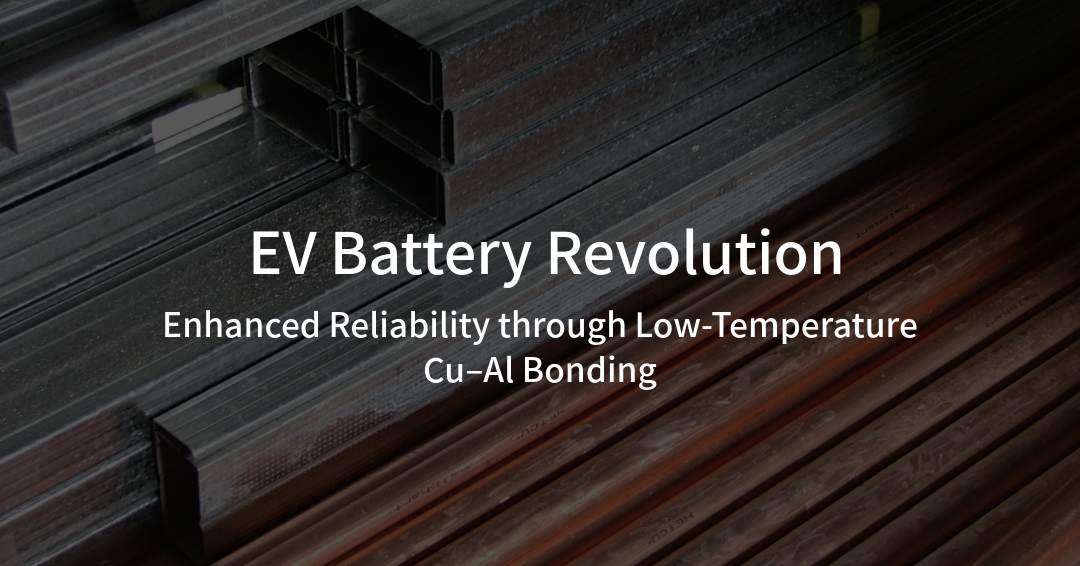As Electric Vehicles (EVs) rapidly gain global adoption, automotive manufacturers are prioritizing battery safety and reliability above all else. At the core of battery assembly is joining technology, a field long challenged by the need for dissimilar material bonding. Specifically, the combination of Copper (Cu) and Aluminum (Al)—used in external terminals and busbars—has driven the need for dissimilar welding to improve quality and reduce costs. Yet, achieving reliable "welding" for this combination remains an enduring, difficult problem.
table of contents
The Challenge of Cu–Al Joining
Achieving a durable joint between copper and aluminum is a universal hurdle in the battery manufacturing industry:
- Copper (Cu): Used for the negative electrode; offers excellent conductivity and relatively high mechanical strength.
- Aluminum (Al): Used for the positive electrode; is lightweight, cost-effective, and also highly conductive.
The ability to directly bond these two materials would enable high-quality, high-efficiency, and lower-cost battery packs. However, conventional welding—a process that melts the materials—creates brittle intermetallic compounds (IMCs). These IMCs increase electrical resistance and raise concerns about mechanical strength degradation over time. Furthermore, any process involving melting and re-solidification risks internal defects like voids and external contaminants like spatter. Prioritizing quality often forces manufacturers to resort to high-cost methods like bolt fastening or using clad materials.
LINK-US's Solution: Ultrasonic Complex Vibration Bonding (USCB)
The Ultrasonic Complex Vibration Bonding (USCB) technology developed by LINK-US offers a novel solution to the challenges of dissimilar material joining.
The key feature is solid-state bonding achieved through complex vibration. This process bonds materials without melting them, and the complex vibration minimizes material damage while effectively achieving an atomic bond.
The results are transformative:
- Minimal Heat-Affected Zone (HAZ): Reduces material degradation, oxidation, and residual stress.
- Suppressed Intermetallic Compound Formation: Ensures a highly durable joint resistant to long-term degradation.
- Spatter-Free Process: Reduces contamination inside the cell, lowering maintenance, cleaning, and downtime.
- Superior Dissimilar Joining Capability: Complex vibration even enables challenging bonds like Cu–Ni clad materials.
Fig. Sample of Tough Pitch Copper (over 2mm thick) bonded to A1050-O, showing the cross-section and fracture condition.
USCB is even showing potential for joining organic and metallic materials—a feat previously deemed impossible with standard ultrasonic bonding. More on this in a future blog post!
Impact on EV Battery Manufacturing
Integrating USCB into EV battery module and pack production delivers significant benefits:
- Improved Performance via Lower Resistance: Reduced joint resistance enhances charge/discharge efficiency, extending driving range.
- Extended Lifespan: Compared to conventional joints that degrade from thermal and stress cycling, USCB offers superior stability, prolonging battery life.
- Enhanced Safety: The process mitigates risks of short circuits from spatter and reduces the likelihood of thermal runaway or rupture caused by joint degradation, thus lowering the risk of fire or explosion.
- Improved Manufacturing Efficiency: Eliminating cleaning and rework associated with weld spatter and fumes increases production line throughput and reduces downtime.
Future Outlook
As the EV industry continues to accelerate toward higher capacity and higher power batteries, the demands on joining technology will only intensify. USCB is poised for application in:
- Next-generation high-power secondary batteries
- Solid-state secondary batteries
- Stationary secondary batteries for social infrastructure
Its distinct features—low-heat process and dissimilar material compatibility—significantly expand the range of material choices and increase design flexibility.
Summary
Achieving high-quality, dissimilar Cu–Al joining was a major challenge in EV battery manufacturing. LINK-US’s Ultrasonic Complex Vibration Bonding technology delivers the necessary quality and reliability. The low-heat, high-reliability joining revolution in the EV industry starts here.
→ For detailed technical review or to discuss a Proof of Concept (PoC), please contact LINK-US.

